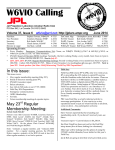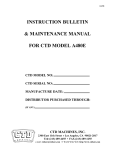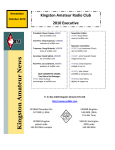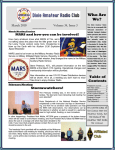Download CAARA Newsletter - Cape Ann Amateur Radio Association
Transcript
CAARA Newsletter AN ARRL AFFILIATED CLUB AN ARRL AFFILIATED CLUB President’s Corner Another fabulous month at CAARA–seems like our dance card is pretty full these days and February by Stan-W4HIX was no exception. One major thing that has been going on at the club is a major cleanup and organization. Several members have been working overtime on combing through the backlog of gear that has been donated to the club, examining and separating the keepers from the not-so-keepers. Speaking of not-so-keepers, a lot of stuff when out the door to the hamfest at Marlboro this month. The club dumped a lot of very marginal stuff and came away with a few hundred dollars. Though a bunch of the stuff came back, there’s always MIT. Another exciting thing that happened was getting one step closer to taking possession of a very nice utility trailer from the City of Gloucester. CAARA will be working in conjunction with the Gloucester Emergency Management Dept on a mobile communications trailer. Part of the function (which has already started) is using it to store gear. The Field Day tents are now being stored in the trailer and the FD kitchen suppliers will soon be there. This is freeing a lot of space up at the club—a good thing, because we seem to be getting a lot of visitors these days. We also started Field Day planning—we already have permission to use Fuller School again this year, and with some work, we should be using the trailer’s office area as an operating station. This year we hope to build on the success of last year for a really great time. I want to express my sincere thanks to everyone who is pitching in—CAARA is a great club. The enthusiasm and camaraderie are fantastic. People joint the club because of our members and activities including CW classes, contests, exploring new gear and just face-to-face rag chewing. See you around the clubhouse. 73 de Stan, W4HIX MARCH ISSUE- 2012 JUNE ISSUE- 2009 Clerk’s Corner This month I would like to focus on just some of the basic benefits of the the clubs website for our membership. The website has been designed as a resource tool for members as well as a portal to make paying yearly membership dues easy and keeping members information up to date. Just in the past year the Board of Directors has added a “Payments and Donations” section which is connected to Paypal so you can pay your membership dues online with your credit card. This saves the club money and saves our members time and moey as well. CAARA members can also now update all of their membership contact information on the clubs website by going to the “Member” section. This makes it easy for our members to keep all their contact information up to date so the Board of Directors and other members can contact them if even if they move,change a phone number or an e-mail address. The clubs website is a great resource tool for all our members as they can find the CAARA Constitution and Policies so they know how the club is run and their rights as members. The clubs website is also a great educational tool for members new and old. In the “New Ham” section we have over 20 links to major amateur radio manufacturers and dealers and in the “Helpful Links” section there are about 30 links to a wide variety of amateur radio information. CAARA members can also find out the history of thier club by looking through all the old CAARA newsletters from the 80`s and 90`s in the members section. There is also a great wealth of information available to club members in the regular “Newsletter Archives” page which covers all that CAARA has done since December 2008 to today. So fi your a new member or an old timer I invite you to grab a beverage and take a good look through your club website. A lot of work by a lot of CAARA members has been put into this resource for your benefit so go to www.caara.net and if you have any suggestions on how to make the website better please e-mail me [email protected] . 73‘s Dean Burgess KB1PGH -CAARA Clerk CAARA Newsletter Cape Ann Amateur Radio Association 6 Stanwood Street Gloucester, MA 01930 CAARA Newsletter is a monthly publication of the Cape Ann Amateur Radio Association (CAARA). It is the policy of the editor to publish all material submitted by the membership provided such material is in good taste, relevant to amateur radio and of interest to CAARA members, and space is available. Material is accepted on a first come, first serve basis. Articles and other materials may be submitted by internet to Jon at [email protected]. If possible, material should be in Word format.Material may also be submitted as hard copy to Jon-K1TP or any Club Officer. All material published in the CAARA Newsletter may be reproduced for noncommericial use provided such use credits both the CAARA and the author of the article. Copyrighted material will not be accepted without accompanying written permission to publish. The opinions expressed in the CAARA Newsletter are solely those of the editor or other contributors and do not necessarily reflect the opions of either the Board of Directors or membership of CAARA. Jon Cunningham- K1TP Editor Dean Burgess- KB1PGH Cub Reporter Board of Directors- 2011-12 Welcome to CAARA: CAARA, an ARRL affiliated club, operates the 2 meter W1GLO repeater on 145.130 MHz with antennas located on the Cingular tower in the Blackburn Industrial Complex in Gloucester Massachusetts. It has an average effective radius of 60 miles, and serves Eastern Massachusetts, Cape Cod, Rhode Island, Southern New Hampshire, and maritime mobile stations. CAARA also operates the W1GLO repeater on 224.900. The former W1RK 443.700 repeater with antennas located in Magnolia is now located at the CAARA clubhouse and has a very limited range. The Association is one of the few amateur radio clubs that has its own clubhouse. Located at 6 Stanwood Street in Gloucester, it includes a permanent HF station with rotating beam and vertical antenna along with a 2 meter packet station and 2 meter voice and 220 MHz transceivers. Amateur radio exams are held on the second Sunday of each month at 10:00AM at the CAARA clubhouse. Anyone who is considering a new license or an upgrade, is welcome to test with us. There is no pre-registration necessary. Contact the head of our VE team Bob Quinn if you have any questions about monthly testing. President: Stan Stone W4HIX Vice Pres: Dick Mac Pherson WB1W Treasurer: Hank McCarl W4RIG Clerk: Dean Burgess KB1PGH Monthly member meetings are held on the first wednesday of each month at 7:30 PM except for July and August. Directors: Paul Anderson, KA1GIJ Jon Cunningham, K1TP Charles Downey, N1OCT Joseph Perry, KB1VQF Dick Ober, K1VRA Don Swenson, N1UVV Ruth HodsoHodson- WW1N Each Sunday evening at 9:00pm, the club operates a 2 meter net on 145.130. This is an open and informal net which disseminates club news and prepares operators for emergency communications work. All are invited to check into the net as club membership is not a requirement. The club held its monthly members meeting on Wednesday, February 1st at the CAARA Clubhouse on 6 Stanwod Street in Gloucester. This month we discussed all the current goings on at the club and we watched a half hour ARRL DVD on Amatuer Radio Foxhunting and Radio direction finding. This video followed around a group of Foxhunters down in Southeastern Massachusetts in their vehicles as they pursued the radio fox hidden deep in the woods miles away. For the March Members meeting we have Steve Schwarm W3EVE as a guest speaker and he will show all of the ins and outs of how the amateur radio service is used to support the Boston Marathon. It involves organizing 200 hams over 20 frequencies over a straight line 26.2 mile course! The members meeting will be held on wednesday March 7th at 7:30 PM at the CAARA clubhouse. ARRL FIELD DAY 2012 IS COMING !!!!!!! The Cape Ann Amateur Radio Association will once again be particpating in the yearly ARRL Field day exercise which will be coming up on Saturday June 23rd and Sunday June 24th 2012. The location will be the same as last year at the Fuller School field. We are in the early planning stages and Caara Club President Stan Stone W4HIX and CAARA Club Treasurer are this years field day CoChairs.ARRL Field day is part portable operations,part contest,part Emergency Communications exercise, part public relations and a good all around fun time for 24 hours straight. As always we are strongly encouraging all new hams to particpate in field day as it is an invaluable learning experience. So mark your calendar now for this weekend in June and join the fun! In the picture above is Jake Hurd- K1LDL and Paul McDonough -W1LPM working 20 meters in the CW tent. More information about ARRL Field day can be found by clicking on the “ARRL Field Day” link on the front page of the CAARA website at www.caara.net . DXCC Country/Entity Report According to the Amateur Radio Cluster Network for the week of Sunday, 29th-January, through Sunday, 5th-February there were 229 countries active. Countries available: 3A, 3B8, 3C, 3D2, 3DA, 3V, 3W, 4J, 4L, 4O, 4S, 4U1I, 4W, 4X, 5B, 5H, 5N, 5R, 5U, 5W, 5Z, 6W, 6Y, 7P, 7Q, 7X, 8P, 8Q, 8R, 9A, 9G, 9H, 9J, 9K, 9L, 9M2, 9M6, 9N, 9Q, 9V, 9Y, A2, A4, A5, A6, A7, A9, AP, BV, BY, C2, C3, C5, C6, CE, CE9, CM, CN, CP, CT, CT3, CU, CX, D2, DL, DU, E7, EA, EA6, EA8, EA9, EI, EK, EP, ER, ES, ET, EU, EX, EY, EZ, F, FG, FH, FJ, FK, FM, FO, FR, FW, FY, G, GD, GI, GJ, GM, GU, GW, HA, HB, HC, HH, HI, HK, HK0/m, HL, HP, HR, HS, HZ, I, IS, J2, J3, J5, J6, J8, JA, JD/m, JT, JY, K, KG4, KH0, KH2, KH6, KL, KP2, KP4, LA, LU, LX, LY, LZ, OA, OD, OE, OH, OH0, OK, OM, ON, OX, OY, OZ, P2, P4, PA, PJ2, PJ4, PY, PZ, R1FJ, S2, S5, SM, SP, ST, SU, SV, SV/a, SV5, SV9, T2, T32, T7, T8, TA, TF, TG, TI, TJ, TK, TL, TN, TR, TT, TU, TY, TZ, UA, UA2, UA9, UK, UN, UR, V2, V3, V4, V5, V7, V8, VE, VK, VK0M, VP5, VP6, VP8, VP8/h, VP9, VQ9, VR, VU, XE, XU, XW, XX9, YA, YB, YI, YL, YN, YO, YS, YU, YV, Z2, Z3, ZA, ZB, ZC4, ZD7, ZD8, ZF, ZK2, ZK3, ZL, ZP, ZS FEBRUARY CAARA VE TEAM RESULTS Caara ARRL VE Team leader Bob QuinnWV1A congratulating Marco CarnovaleKB1TZG for passing his FCC General Amateur radio License exam at the CAARA club’s February amateur radio license test session on Sunday, February 11. NEW ARRL EMCOMM BOOK RELEASED !!! For those CAARA members who are into emergency communications the Amateur Radio Relay League has released the second edition of Emergency Power for Radio Communications. The book has 12 chapters covering all the methods of keeping your amateur radio equipment powered up when the power grid goes down. The book discusses such aspects from solar and battery power to generators and emergency lighting. It also has an appendix at the end on how to install Anderson powerpole connectors which are the ARRL Amateur Radio Emergency Services approved way to connect to emergency power sources during any ecmomm deployment.I would highly recommend this book for anyone starting out in amateur radio emergency communications or for those like me who have to operate HF portable.It‘s good to have a dedicated resource book on this subject.The book is $27.95 and can be ordered by going to www.arrl.org . 73‘s Dean Burgess KB1PGH CAARA members Marco Carnovale- KB1TZG and Robert Claypool- KB1WJC holding up their TenTec multimeter rewards given to them by Jake Hurd- K1LDL for passing their General exams at the club’s February VE Session. CAARA VE Team leader Bob Quinn would like to inform the membership that the Cape Ann Amateur Radio Associations ARRL Volunteer Examiner team tested 46 candidates and awarded 42 new amateur radio licenses in year of 2011! HAM TIPS The transmatch, or ham radio antenna tuner, is a variable impedance matching device. It is used between the transmission line of an HF antenna system and a transceiver or transmitter. Its purpose is to make the antenna system “look like” a purely resistive load - usually 50 Ohms. The ham radio operator varies the inductance, along with input and/or output capacitances, in an effort to “tune out” (cancel out) the capacitive and/or inductive reactances that may appear at the transmitter end of the transmission line. Why match the antenna system impedance to the transmitter’s output impedance? Because maximum transmitted energy is transfered to the load when the load matches the characteristic impedance of the transmitter output (usually 50 Ohms). Please note that the transmatch - when installed between the transmitter output and the transmission line . . . • will not eliminate the standing waves that may appear on the transmission line and will not eliminate the signal lost as heat within the transmission line due to the standing waves. • will not tune the antenna to resonance, at the other end of the transmission line (an unfortunate popular misconception). CAARA would like to welcome these new members of CAARA... Jeff Demers N1NSB Scott Harrison KD1Q Vaughn Hawley K2PAX Joseph Gifun KB1VZQ Matt Allred KB1WGC HAVE YOU VISITED THE SECOND FLOOR OF THE CLUB AS OF LATE? WE HAVE BEEN CLEANING AND ORGANIZING ALL THE GEAR. WE HAVE SEVERAL STATIONS THAT ARE READY TO USE. YOUR MEMBERSHIP INCLUDES THE USE OF THE CLUB EQUIPMENT AND TEST GEAR! Top picture of the second floor service area. Jake is standing in front of the Kenwood 820 station hooked up to a Butternut Vertical antenna. Above left photo is our cw station consisting of the club TenTec HF transceiver and an Icom 706MKIIG with antenna tuners to the hf beam or vertical antenna. The photo above is the beginning stage of a working vintage station consisting of our Kenwood 830 with all the matching accessories as well as vintage Clegg gear for 6 meters. Left photo is our second floor digital station, we also have a hf digital station on the first floor. Pic #1 : The Yaesu FT 817 is growing in popularity with several CAARA members. Here is CAARA member Matthew Allred- KB1WGZ‘s portable HF set up with his FT 817 with his homemade dipole and Nifty Quick Manual in the bag and all safe and sound in a heavy duty carry case. Many club members are having fun setting up portable and operating QRP with this rig which operate 5 watts max on HF.Matt has his Technician license and is taking advantage of his 10 meter privileges. He has already talked to Colorado on SSB with only 5 watts RF power! Pic#2 Here‘s a picture of CAARA member Ruth Hodsdon- WW1N leading the Thacher’s Island W1T planning meeting on the second floor of the clubhouse on a Sunday morning. Antenna Adventures by Curtis- AA3JE I don’t know why it is always winter. There is an eternity of summer days when there is no wind, its balmy and clear, and it would be so easy to do antenna work. For some strange reason, however, summer days tend to fill up with sailing, gardening, trips to the beach, house guests and similar things. It is only on the cold, windy, snow-filled days of December and January that I find myself sitting by the rig wondering if there is anything I can do to improve the miserable reception I always seem to have. The problem is simple. I have already been divorced once and don’t want to repeat the process. When I find the perfect antenna in the latest catalog, and share my find with my spouse, she always seems to ask questions I cannot answer. Like, “Where are you going to put it?” which is followed by “and where are you going to live, then?” It seems that the joy of having a 60 foot tower sitting in the back yard is lost on my spouse, who prefers apple trees with small birds flitting among the branches. She is also very firm on strands of copper wire draped in the trees, which she does not think lend a puckish air of informality to the garden. So I hunt, and hunt, and buy books labeled “Stealth Antennas, Your guide to defeating zoning restrictions.” and similar things. I also tend to look around the property for places I might hide an antenna, where she never goes. This never seems to work well, since her pet dog has a very acute sense of smell, and is always very interested in where I am and where I have been. The dog goes, she follows, and I am discovered holding the end of a wire leading off into the neighbor’s yard. I had pretty good performance with various kinds of loop antennas, fed by a SMARTUNER, but found that they generated a strong magnetic field that had unfortunate effects. The last try ended up setting off the carbon monoxide detector which (to my horror) had a voice chip. I had just tuned up on 80 meters when I keyed down for one last check and was interrupted by a shriek of doom from the machine. “Danger! Hazardous carbon monoxide levels are present! Evacuate immediately.” I tried holding a towel over the thing while I pushed buttons. It only seemed to make it worse..... “Curt? CURTIS!, What’s going on? You get Beau and I’ll get Daisy! meet you on the lawn!” “It’s nothing dear” “DANGER, DANGER EVACUATE AT ONCE!” “Nothing? NOTHING! What have you DONE?” “Just a little technical trouble” I tried a calming voice. This was a mistake. “I knew you’d poison us someday! I will discuss this outside. AFTER I call my lawyer.” It was a cold December evening and lights were going on in all the neighbors houses. I had just explained what had happened when the fire truck showed up. Seemed one of the neighbors had called to help us out. They were followed by a police care and a few of the stalwart souls that live by their scanners and are always hoping for (or setting) a good fire. In a few minutes we had a good crowd. “Defective smoke detector” I lied. “We need to go in and check it out sir.” “Ok.” After all the fuss was over, I made up the couch (I knew I’d get no sleep in the bedroom) and decided that I needed a new antenna. This was a problem. There were a LOT of really nice antennas in the catalog, but I was not sure if my idea of “nice” would be shared by my spouse. I did not want to risk the R-7000 event again. The R-7000 was a nice, clean, multi-band antenna that I bought when my spouse said I could have ONE antenna. I started to put it together in the garage. I soon found I ran out of room, so I opened the window in the rear and stuck one end out the back. I kept adding sections and soon ran out of room again, so I opened the garage door, set up a new sawhorse, and kept building. I was just putting the whip on, while standing in the street, when I heard the tapping on the window. My wife feels that it detracts from the tone to yell, so she taps discreetly to gain my attention. I have come to dread it. She saw I had noticed and gestured that I come to the door. “Yes?” “It’s higher than the house. Where are you going to put it?” “Oh just in back, right up against the eaves.” “You mean five feet from the smoke detector?” She had a point. I disassembled it. I got $20 for it. I kept looking, and finally, at one hamfest, I spotted an antenna that looked perfect. It was only a three bander, but it was only about 24 feet, light, slender, and best of all it was used and cheap. I never stopped to wonder why it was for sale. I bought it on the spot, found a site on the property, sank a 4 by 4 post, and set out a web of ground radials cut to the right frequencies. I had down-loaded the manual, and started assembling. It was a breeze! I had it up and then realized I had to run the feed line into the house. This caused a brief quandary. In a fit of absent mindedness I had promised my wife I would not drill holes in the house (she gets nervous when I disappear holding a cordless drill and a 1 inch bit) and none of my existing holes were nearby. It took a while but I finally realized I could pop out the casement window and craft a panel (nice one with copper grounding) that I could drill to a fair thee well. I ran cable, affixed feed-throughs, and had it all wired in a minute. I kicked on the rig. “SWR OVERLOAD”. Not possible. Oh well, just needed a little tuning. Trouble was that to tune the antenna I had to go outside and dismount it, shift the tubing, and re-mount it. It was snowing. Hard. I spent the better part of the day doing the tune-adjusttune-adjust-tune-adjust cycle. I finally decided to re-read the manual. “Under no circumstances EVER try to adjust the depth of insertion of the traps in the coil. Doing so will void the warranty as trap adjustment takes special rigs and tuning equipment.” I had been carefully de-tuning every one of the traps. By mistake. I carefully dismounted the antenna and bundled it up, taking it to the Rockport transfer station. One word of caution. If you see a nice little tri-bander in one of the local junk shops, be a little cautious. Me? I’m waiting for next December. I have a few ideas. Jake- K1LDL has been restoring a Collins 75A3. Before and after pictures of the chasis. Jake replaced old electrolytics whcih removed the AC hum from the audio and replaced a cracked 2 watt carbon resistor and the radio is alive! Another Ebay bargain which will give Jake many years of service. Marlboro Flea Market....that is our messy MIT offer free online electronics course CAARA table packed with bargains! A free, certificated, on line course in 'Circuits and electronics' is now open for registration at https:// 6002x.mitx.mit.edu/The course is certificated by MIT under an honour code. Looking at the textbook associated with the course I have to say that the mathematics requirement is significant (and beyond me!). But for those of us who have had some formal training in maths and physics and can deal with calculus, linear algebra and differential equations, this course promises to be quite exciting. Below is a shot from the Marlboro Flea Market. club members Jon-K1TP, Stan-W4HIX, HankW4RIG, Jake-K1LDL, Dick-KR1G, and ChuckN1OCT attended. What‘s up on the Watts UP! by Dean Burgess KB1PGH If you like to,or in my case-have to, operate portable HF like I do you know you have to bring a power source for your rig.Now if you are using a battery source instead of a generator you know that you only have a certain amount of energy until the battery can no longer make the radio work.This is especially true when you want to make sure that you have enough battery energy to run your HF rig properly and even worse you should know how much battery life you have left in Volts so you don‘t discharge the battery too much.In the past when I operated portable with my deep cycle marine batteries I always had to check the battery voltage as I operated so I wouldn‘t go below 10.5 Volts as not to discharge the battery too much and risk damaging it.The only way I could do that was to get the multimeter out time and time again.I also didn‘t know how much Amp Hours I had left on the battery to operate portable.As you know the number of amp hours on the battery will generally tell you how much time you have to operate.Of course you have to factor in current draw and how many RF watts you put out,but that dicussion is for a later time. I then saw on Youtube a portable HF set where someone was using a “Watts Up “ meter. The “Watts Up” meter is a DC inline meter which constantly displays 7 parameters. The “Watts Up” meter measures Amp Hours,Watt Hours,Voltage,Watts and captures Peak Amps,Watts andVoltage.The meter connects between the source and the load.The load being the battery and the load being the radio.As you can see in the picture I am holding the “Watts Up” meter in my hand so you can see the relative size of the meter.The meter is connected between my deep cycle battery and my Icom 7000 via Anderson Powerpole connectors which already come installed on the “Watts Up” meter.As you see in the photo the meter is displaying on the upper left that the Icom 7000 is drawing 1.18 Amps on receive,on the upper right you can see that my battery has 12.46 Volts of power.On the bottom right you can see that the “Watts Up” meter is seeing that my Icom 7000 is drawing 14.7 watts of power on receive.On the lower left you can see that my radio is “Peaking” at 2.9 Watt Hours.The lower left display goes back in forth displaying all the peak parameters.The “Watts Up” Meter works on any Battery source from 12 to 48 Volts and on any type of battery up to 60 volts.You can also think of dozens of uses for this meter.It is also heavily used in the Radio Controlled plane hobby to monitor the electric motors and to peak power performace any electric device.The “Watts Up” meter is very small and light and is made of sturdy plastic molding.The display is also easy to read.I would recommend this meter to all who operate HF portable.It is certainly going to make my life easier monitoring my power sources.The “Watts Up” meter is $ 59.99 and is available at www.powerwerx.com . 100th Anniversary Titanic Special Event- W0S The 100th Anniversary Titanic Special Event W0S will be held this year on the 13th 14th 15th of April 2012. The 13th will be a QRP event and starting at 8am Saturday the 14th running thru Sunday the 15th till around 4 pm will be the main event. This year we are asking clubs to sponsor a radio and run it the whole weekend or if we can get a big turn out, make it into blocks of time. This is the 100th anniversary of the sinking of the Titanic and we want to make this a huge event. Please ask your club members to come as a club or an association to be apart of a great event!! More info to follow as it becomes available. Please contact Richard Vogt KB9YZE or Rod Kettleman K0ADI for more information. Rich Vogt [email protected] Rod kettleman [email protected] www.w0s.org or www.wzeros.com New pressure on jammers of international broadcasts The International Telecommunication Union (ITU) has called upon the world’s nations to take 'necessary actions' to stop intentional interference with satellite transmissions. The change in ITU regulations, which was approved at the just-concluded World Radiocommunication Conference (WRC-12) in Geneva, Switzerland, came after numerous complaints that international satellite TV programmes in Persian and Arabic were suffering from deliberate interference, known as “jamming”. Two satellite operators that have been targeted, Eutelsat and Arabsat, said the interfering signals originated from Iran and Syria. “We are gratified to see the World Radiocommunication Conference take a position on this vital issue,” said Richard M Lobo, Director of the United States International Broadcasting Bureau. “Of course, it remains to be seen whether Iran, Syria and other countries which interfere with international satellite communications will change their practices. Jamming is a fundamental violation, not only of international regulations and norms, but of the right of people everywhere to receive and impart information,” Lobo said. The interference, which has increased since September, 2011, affected broadcasts of the British Broadcasting Corporation, Broadcasting Board of Governors, Audiovisuel Extérieur de la France RFI and France 24 TV, Deutsche Welle, and RFE/RL, Inc’s Radio Farda. Joining in backing the ITU rule change were Radio Netherlands Worldwide and the European Broadcasting Union. The change in the regulation came after hours of discussion and debate, both in small groups and on the floor of the WRC. A report by the ITU’s Radio Regulations Board noted “the persistent character of the harmful interference” and the fact that “in some cases, the administrations involved have not responded … and appear to take no action to resolve the interference.” The revised language says administrations “shall ascertain the facts and take the necessary actions” when they encounter jamming. Another shot of the recent Marlboro Fleamarket. Prior to the WRC action, the Directors-General of five major international broadcasters charged that jamming is a violation of Article 19 of the Universal Declaration of Human Rights. Reporters Without Borders called for nations to “firmly condemn countries that do not respect the fundamental principles of the free flow of information,” adding, “the ITU must not be the accomplice of regimes that obstruct the flow of news and information on their telecommunications networks.” The International Campaign for Human Rights in Iran termed satellite jamming part of a broader effort. “The Iranian government is also engaged in comprehensive attempts to take complete control of online access to the internet as well as restricting mobile voice and data communications,” the group said in a statement urging the WRC to address the jamming issue. You know when you’re a Hamaddict when; § You wait for a nice snowstorm to build your next antenna. They will always work better! § Will actually spend 10 minutes listening to the other station describe his triple bypass surgery in order to finally get a signal report. § Tell the xyl you need a minute to check something on the radio and show back up 3 hours later. § Spend Valentines Day at Radio Shack looking for 12 volt relays. § Read and absorb every word on W8JI’S website! § Go to Eham or DX summit before checking your email. § Line your birdcage with a complimentary issue of CQ magazine. § Have your ham radio activities come up during your divorce proceedings. § Venture into your backyard at 2am in 10 degree weather to check for icing on your antennas with a spotlight able to be seen from space. § Buy a house based on available antenna trees with proper orientation. § Quit smoking so your equipment will maintain its resale value. § Never read the manual to your new radio till after a week or so, when you are totally convinced it might actually be helpful. § Don’t kick the cat because your final pull up line has found the only remaining leaf in your yard and has successfully tangled at 50 ft high in your only antenna tree. § Have enough buried and knotted up copper wire in your backyard to feed a third world country. § Have told a nosey new neighbor that you are a NSA volunteer listening station. § Keep your comments to yourself when the self proclaimed antenna expert with crappy audio and a 2 by 2 signal is having an orgasm about his multiband 20 ft vertical being able to work Italy, and will share the design on his QRZ page. § Leave your own Super Bowl party early so you can check your new antenna on the greyline. § Set up a remote station at work to play with some digital during your “free” time. § Drive 400 miles to pick up an amp to avoid shipping costs and possible damage. § Intercept the UPS guy before that new big box ends up on your porch. Lying to xyl never a good idea, subterfuge much better method. § Always remember to answer “Is that thing in the backyard permanent?” with “Of course not, just a quick experiment be gone in a few days” Not. § Still working on that antenna book that’s going to take care of retirement bills. § Dislodge a chimney brick while pulling down a stuck homebrew Windom because of perceived coupling with wire beam. Turns out to be bad barrel connector in the shack! § Spend way too much time writing articles for eHam. 100 years since the Titanic On April 15, 2012 it will be exactly 100 years since the Titanic collided with an iceberg and sank. It is not necessary to tell you the whole story once again; others did this at length, even with a movie. You should also know that there were Flemish passengers on board and some of them did not survive this disaster. As radio amateurs we pay special tribute to wireless operator Jack Philips who acquitted himself of his task until the very last gasp and continued broadcasting the distress signal “CQD” (predecessor of SOS) as long as he could. 704 people (including 7 Flemings) were rescued. 1504 people lost their life (including 14 Flemings). Jack Philips himself went down with the ship. In the logbook of wireless operator Cottam of the ‘Carpatia’, which was in the area at that time, we read the following: April 14, 1912: 23:20 PM – CQD SOS TITANIC – collided on iceberg 23:30 Carpatia changes direction April 15, 1912: 00:10 Titanic calls CQD, transmitting power weakens 00:20 Titanic sends series of V’s, signals irregular 00:25 Calling Titanic, no answer 00:28 Titanic calls CQD, broken signals, stops suddenly 00:30 Repeated calling Titanic, no answer 01:25 Calling Titanic, flares fired, no answer. To honor this brave wireless operator and to commemorate this disaster, V.R.A.vzw (Vlaamse RadioAmateurs, which means Flemish Radio Amateurs) will put special callsigns on the air from April 1, 2012 until April 30, 2012.: OO100MGY by our section RACD in Deurne (Antwerp) OR100MGY by our section KUST in Knokke-Heist OT100MGY by our section PRAC in Londerzeel During the weekend of Saturday April 14 until Sunday April 15, all three stations will be active during a marathon transmission, from Saturday 14:00 local time until Sunday 18:00 local time (UTC from 12:00 Saturday until 16:00 Sunday) Each of these stations has a special and unique QSL-card available. So, 3 (three) different qsl-cards can be acquired, one for each participating station Whoever succeeds in getting these 3 different qsl-cards may request a special award (see above). This can be done by means of a signed GRClist, co-signed by 2 (TWO) other licensed radio amateurs and by paying the amount of €15,00 (in Europe), or €20,00 (outside Europe), postage included, on the account number: IBAN code = BE 9795 2518 6192 BIC code = ARS PBE 22 Of: V.R.A. vzw, Brusselsesteenweg 113, B-2800 Mechelen (Belgium) Mention your call + “Titanic Award”. Hey Dean , Here is our Ipswich Dispatch Center Picture below is an overall view pic 167 is our E911 the left screen is the GPS screen which pinpoints the location of the call whether it is home phone or cell phone. the screen to the right is the information screen which gives name call back numbers and address confirmation. this is also the screen that is used for tty calls to type to hearing impaired individuals. Picture on top right is our zetron. this controls all our radios, tones for the fire dept. and operates all of our doors in the station. it runs our UHF Public Safety, VHF Public Safety, 2M, and Marine frequencies. Picture on the right middle is our radio bank. These radio’s are controlled by the zetron but also can be used manually. Top is UHF, VHF, VHF. Then below that is our camera and door and cell block intercoms and the the LW bills fire alarm panel. the tv screens monitor on duty assignment status as well as our security and cell block cameras. The radio below is our MEMA 800mhz radio. Hope these pics are what you were looking for. If you need any more descriptions or anything else let me know. 73’s, W1HUB New Antenna Analyzer at K1TP’s Shack RigExpert AA-54 is a powerful antenna analyzer designed for testing, checking, tuning or repairing antennas and antenna feedlines. Mainly, these are SWR (Standing Wave Ratio) and impedance measurement instruments (vector impedance analyzers). Easy-to use measurement modes, as well as additional features such as connection to a personal computer (to plot Smith diagrams, etc.), make RigExpert AA-30 and AA-54 attractive for professionals and hobbyists. It is quite important that graphical display of various parameters over a wide frequency range is a key feature of these analyzers which significantly reduces the time required to adjust an antenna. The following tasks are easily accomplished by using RigExpert AA-30 and AA-54: • Rapid check-out of an antenna • Tuning an antenna to resonance • Antenna SWR and impedance measurement and comparison before and after specific event (rain, hurricane, etc.) • Making coaxial lines or measuring their parameters • Cable testing and fault location • Measuring capacitance or inductance of reactive loads What I like about the tester in comparison to my old Autek Antenna Analyzer is the fact that it can simultaneously check a multi-band-band antenna (such as a vertical or yagi) and display a plot of the swr over a given bandwidth of all the bands that you specify. The results are saved on the tester and you can then load them on to your computer with the provided software and a USB cable for future reference. The tester comes with a user manual but the manual is also available right on the tester screen which is great for operation in the field. The AA-54 was in the review section of this month’s QST and was given a very good review. The tester can be bought for just over $300.00 from Rig Experts in Texas. The reviews on Eham are very good and you can see it in action on Youtube just by searching for AA-54. March CAARA Clubhouse dates Saturday, March 3rd @ noon thru Sunday March 4th ARRL SSB Worldwide Contest Wednesday March 7th: CAARA members meeting @ 7:30 PM Sunday March 11th: Monthly Amateur Radio License/VE test session @ 10 AM Wednesday March 14th: Monthly Emergency Communications Group meeting @ 7 PM Wednesday March 14th: Monthly Board of Directors Meeting @ 7:30 PM Sunday March 25th: Monthly Scholarship Benefit Breakfast @ 8:30 AM Every Sunday Morning: Coffee and Donuts at 9:00 AM to noon Every Sunday Night: CAARA NET at 9 :00 PM on 145.130 MHZ with no Pl tone Jon, Going through some of my old stuff (junk) and found an old (1972) publication from Wayne Green. Thought you might be interested in the cover for a page in the newsletter. Also has some interesting info & pics inside. Dick-WB1W Mystery Item....what is it? answer on the last page You can get your FCC Technician Amateur Radio License in One Day with Tech-in-A-Day Note: Morse code is no longer needed for any amateur radio license. How? If you can spare one Saturday, chances are very good you can get your amateur radio Technician license. Don’t worry if you’re not technically inclined, this method depends much more on shortterm memory than technical knowledge or background. By spending six hours studying the questions and answers from the FCC exam question pool, you’ll remember enough to pass the exam given at the end of the class. The test is 35 multiple-choice questions and you need 26 correct to pass. This method has worked with teenagers to senior citizens. Why? With a Technician license, you can use VHF and UHF amateur radio bands, meaning when the phones go dead and your cell phone doesn’t get reception, you will be able to get a message out with a simple hand-held radio. For emergency workers, adding Amateur Radio capability adds to your communications abilities. And, it is great fun with interesting people to meet. Help! So after I get my license, what next? The Cape Ann Amateur Radio Association is ready and willing to teach you the practical matters on getting “on the air”. We can answer your questions on how to operate, what radio to buy, etc. We get together every Sunday morning for coffee and donuts—come join us sometime. We also have members’ meetings once a month with interesting presentations. Schedule Date: Saturday, April 28th, 2012 Time: 8:30 AM to 5:00 PM (includes exam) Place: Lanesville Community Center 8 Vulcan St Gloucester (Lanesville), MA Contact Stan Stone, W4HIX 978 283-2015 e-mail: [email protected] You must pre-register for this course. Cost & Requirements Fee: $5 (includes materials & snacks) Test Cost: $15 (required by FCC) Bring photo ID & Social Security Number Cape Ann Amateur Radio Association, Gloucester, MA 01930 THE WOUFF HONG From the 1969 ARRL “Radio Amateur’s Operating Manual” Every amateur should know and tremble at the history and origins of this fearsome instrument for punishment of amateurs who cultivate bad operating habits and who nourish and culture their meaner instincts on the air... This is the Wouff Hong. It was invented -or at any rate, discovered- by “The Old Man” himself, just as amateurs were getting back on the air after World War One. “The Old Man” (who later turned out to be Hiram Percy Maxim, W1AW, Co-founder and first president of ARRL) first heard the Wouff Hong described amid the howls and garble of QRM as he tuned across a band filled with signals which exemplified all the rotten operating practices then available to amateurs, considering the state of the art as they knew it. As amateur technology and ingenuity have advanced, we have discovered new and improved techniques of rotten operating, but we’re ahead of our story. As The Old Man heard it, the Wouff Hong was being used on some hapless offender so effectively that he investigated. After further effort, “T.O.M.” was able to locate and identify a Wouff Hong. He wrote a number of QST articles about contemporary rotten operating practices and the use of the Wouff Hong to discipline the offenders. Early in 1919, The Old Man wrote in QST “I am sending you a specimen of a real live Wouff Hong which came to light out here . . . Keep it in the editorial sanctum where you can lay hands on it quickly in an emergency.” The “specimen of a real live Wouff Hong” was presented to a meeting of the ARRL Board and QST reported later that “each face noticeably blanched when the awful Wouff Hong was . . . laid upon the table.” The Board voted that the Wouff Hong be framed and hung in the office of the Secretary of the League and there it remains to this day, a sobering influence on every visitor to League Headquarters who has ever swooshed a carrier across a crowded band. The Old Man never prescribed the exact manner in which the Wouff Hong was to be used, but amateurs need only a little imagination to surmise how painful punishments were inflicted on those who stoop to liddish behavior on the air. WHY USE CODE TRANSMISSION IF VOICE TRANSMISSION IS SO MUCH SIMPLER? 1. Radio communication by code requires less elaborate, less costly and less bulky equipment than does voice radio communication. 2. Code transmission will penetrate radio and atmospheric interference more readily than will phone transmission. Code transmission will usually be intelligently received under conditions that render voice transmission and reception impossible. The spoken word with it’s inflections, intonation and a tremendous variety of sounds is infinitely more complex than is the single piercing note of a radio telegraph signal. 3. The radio telegraph code constitutes an invaluable method of sending “secret” messages or security information with a greater amount of safety. 4. A transmitted code signal requires much less frequency space than does a radio telephone signal. Approximately 6 KHZ for an AM signal and 15 KHZ for the wideband FM signal. The typical CW signal is 1.5 KHZ. 5. Amateur radio operators use “Q” signals which have common meaning in languages other than English. This permits the exchange of basic information in CW between operators regardless of their English speaking ability. The Morse code is made up of letters as is most spoken languages. The code letters consist of sounds of short and long duration which are called DOTS & DASHES, (sounded like DITS & DAHS). These sounds are usually high pitched tones of about 500 to 800 Hertz or approximately the sound of a high C on a piano. The long sound (DAH) is three times as long in duration as the short sound (DIT). Each letter of the alphabet, each number and each punctuation mark is composed of a different combination of these long and short sounds. Since Morse code consists of sound combinations it is very similar to music. A person listening to the National Anthem hears only the melody and not the individual notes of the music. Morse code is quickly mastered by listening for the “melody” of the letter sound rather than counting the individual dits and dahs. (learn code by sound, do not count the dits and dahs.....sound = character!) REPEAT....LEARN EACH CHARACTER BY SOUND!






















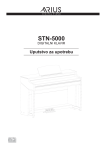

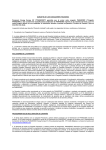
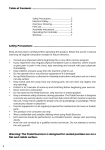
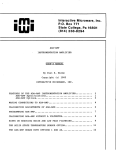
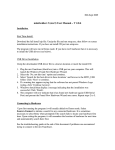
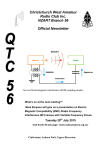

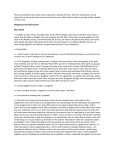


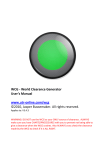
![[Proxyview]User`s Manual (5.1.4.0)](http://vs1.manualzilla.com/store/data/005658349_1-e7f841297d622d23913e7f3fcabf599d-150x150.png)
